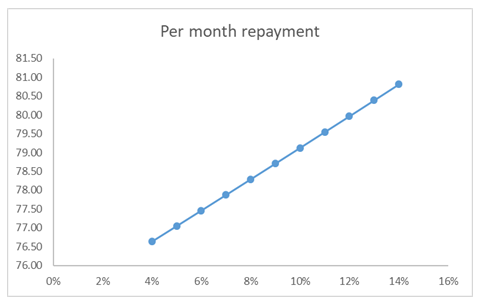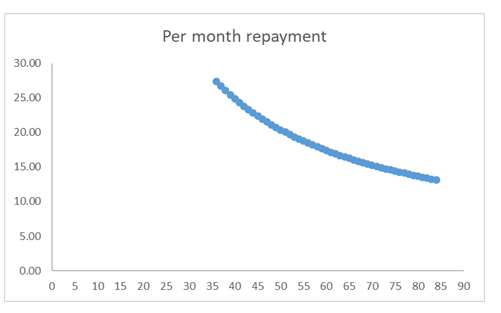
(a)
Graphical representation of monthly payment as a function of interest rate.
Answer to Problem 106P
Graphical representation of monthly payment as a function of interest rate.
Explanation of Solution
Given information:
- Loan Amount - $900
- Time period − 1 years
- Rate of Interest − 4-14% per annum
- Capital Recovery Factor:
The capital recovery factor is used to find the uniform annual amount A of a uniform series from a known present worth at the given interest rate i. It is calculated as:
Calculation:
The loan amount is $900. The monthly payments are to be made, therefore, the rate of interest will be divided by 12, while the time period will be multiplied by 12.
Based on the above information, the following table can be created:
| Time Period (in years) | Time Period (in months) | Rate of Interest (compounded annually) | Rate of Interest (compounded monthly) | Loan Amount to be paid | Per month repayment |
| 1 | 12 | 4% | 0.003 | 900 | 76.63 |
| 1 | 12 | 5% | 0.004 | 900 | 77.05 |
| 1 | 12 | 6% | 0.005 | 900 | 77.46 |
| 1 | 12 | 7% | 0.006 | 900 | 77.87 |
| 1 | 12 | 8% | 0.007 | 900 | 78.29 |
| 1 | 12 | 9% | 0.008 | 900 | 78.71 |
| 1 | 12 | 10% | 0.008 | 900 | 79.12 |
| 1 | 12 | 11% | 0.009 | 900 | 79.54 |
| 1 | 12 | 12% | 0.010 | 900 | 79.96 |
| 1 | 12 | 13% | 0.011 | 900 | 80.39 |
| 1 | 12 | 14% | 0.012 | 900 | 80.81 |
Now, the graph will be plotted between the rate of interest compounded annually and per month repayment. The graph will look as:

(b)
Graphical representation of monthly payment as a function of time period.
Answer to Problem 106P
Graphical representation of monthly payment as a function of interest rate.
Explanation of Solution
Given information:
- Loan Amount - $900
- Rate of Interest − 6% per annum.
- Time period − 36-84 months
- Capital Recovery Factor:
The capital recovery factor is used to find the uniform annual amount A of a uniform series from a known present worth at the given interest rate i. It is calculated as:
Calculation:
The loan amount is $900. The monthly payments are to be made, therefore, the rate of interest will be divided by 12, while the time period will be multiplied by 12.
Based on this information, following table can be created:
| Time Period (in months) | Rate of Interest (compounded annually) | Rate of Interest (compounded monthly) | Loan Amount to be paid | Per month repayment |
| 36 | 6% | 0.005 | 900 | 27.38 |
| 37 | 6% | 0.005 | 900 | 26.70 |
| 38 | 6% | 0.005 | 900 | 26.06 |
| 39 | 6% | 0.005 | 900 | 25.46 |
| 40 | 6% | 0.005 | 900 | 24.88 |
| 41 | 6% | 0.005 | 900 | 24.33 |
| 42 | 6% | 0.005 | 900 | 23.81 |
| 43 | 6% | 0.005 | 900 | 23.31 |
| 44 | 6% | 0.005 | 900 | 22.84 |
| 45 | 6% | 0.005 | 900 | 22.38 |
| 46 | 6% | 0.005 | 900 | 21.95 |
| 47 | 6% | 0.005 | 900 | 21.53 |
| 48 | 6% | 0.005 | 900 | 21.14 |
| 49 | 6% | 0.005 | 900 | 20.75 |
| 50 | 6% | 0.005 | 900 | 20.39 |
| 51 | 6% | 0.005 | 900 | 20.04 |
| 52 | 6% | 0.005 | 900 | 19.70 |
| 53 | 6% | 0.005 | 900 | 19.37 |
| 54 | 6% | 0.005 | 900 | 19.06 |
| 55 | 6% | 0.005 | 900 | 18.76 |
| 56 | 6% | 0.005 | 900 | 18.47 |
| 57 | 6% | 0.005 | 900 | 18.19 |
| 58 | 6% | 0.005 | 900 | 17.91 |
| 59 | 6% | 0.005 | 900 | 17.65 |
| 60 | 6% | 0.005 | 900 | 17.40 |
| 61 | 6% | 0.005 | 900 | 17.15 |
| 62 | 6% | 0.005 | 900 | 16.92 |
| 63 | 6% | 0.005 | 900 | 16.69 |
| 64 | 6% | 0.005 | 900 | 16.47 |
| 65 | 6% | 0.005 | 900 | 16.25 |
| 66 | 6% | 0.005 | 900 | 16.04 |
| 67 | 6% | 0.005 | 900 | 15.84 |
| 68 | 6% | 0.005 | 900 | 15.65 |
| 69 | 6% | 0.005 | 900 | 15.45 |
| 70 | 6% | 0.005 | 900 | 15.27 |
| 71 | 6% | 0.005 | 900 | 15.09 |
| 72 | 6% | 0.005 | 900 | 14.92 |
| 73 | 6% | 0.005 | 900 | 14.75 |
| 74 | 6% | 0.005 | 900 | 14.58 |
| 75 | 6% | 0.005 | 900 | 14.42 |
| 76 | 6% | 0.005 | 900 | 14.26 |
| 77 | 6% | 0.005 | 900 | 14.11 |
| 78 | 6% | 0.005 | 900 | 13.96 |
| 79 | 6% | 0.005 | 900 | 13.82 |
| 80 | 6% | 0.005 | 900 | 13.68 |
| 81 | 6% | 0.005 | 900 | 13.54 |
| 82 | 6% | 0.005 | 900 | 13.41 |
| 83 | 6% | 0.005 | 900 | 13.28 |
| 84 | 6% | 0.005 | 900 | 13.15 |
Now, the graph will be plotted between the time period and per month repayment. The graph will look as:

Want to see more full solutions like this?
Chapter 4 Solutions
Engineering Economic Analysis
- As indicated in the attached image, U.S. earnings for high- and low-skill workers as measured by educational attainment began diverging in the 1980s. The remaining questions in this problem set use the model for the labor market developed in class to walk through potential explanations for this trend. 1. Assume that there are just two types of workers, low- and high-skill. As a result, there are two labor markets: supply and demand for low-skill workers and supply and demand for high-skill workers. Using two carefully drawn labor-market figures, show that an increase in the demand for high skill workers can explain an increase in the relative wage of high-skill workers. 2. Using the same assumptions as in the previous question, use two carefully drawn labor-market figures to show that an increase in the supply of low-skill workers can explain an increase in the relative wage of high-skill workers.arrow_forwardPublished in 1980, the book Free to Choose discusses how economists Milton Friedman and Rose Friedman proposed a one-sided view of the benefits of a voucher system. However, there are other economists who disagree about the potential effects of a voucher system.arrow_forwardThe following diagram illustrates the demand and marginal revenue curves facing a monopoly in an industry with no economies or diseconomies of scale. In the short and long run, MC = ATC. a. Calculate the values of profit, consumer surplus, and deadweight loss, and illustrate these on the graph. b. Repeat the calculations in part a, but now assume the monopoly is able to practice perfect price discrimination.arrow_forward
- how commond economies relate to principle Of Economics ?arrow_forwardCritically analyse the five (5) characteristics of Ubuntu and provide examples of how they apply to the National Health Insurance (NHI) in South Africa.arrow_forwardCritically analyse the five (5) characteristics of Ubuntu and provide examples of how they apply to the National Health Insurance (NHI) in South Africa.arrow_forward

 Principles of Economics (12th Edition)EconomicsISBN:9780134078779Author:Karl E. Case, Ray C. Fair, Sharon E. OsterPublisher:PEARSON
Principles of Economics (12th Edition)EconomicsISBN:9780134078779Author:Karl E. Case, Ray C. Fair, Sharon E. OsterPublisher:PEARSON Engineering Economy (17th Edition)EconomicsISBN:9780134870069Author:William G. Sullivan, Elin M. Wicks, C. Patrick KoellingPublisher:PEARSON
Engineering Economy (17th Edition)EconomicsISBN:9780134870069Author:William G. Sullivan, Elin M. Wicks, C. Patrick KoellingPublisher:PEARSON Principles of Economics (MindTap Course List)EconomicsISBN:9781305585126Author:N. Gregory MankiwPublisher:Cengage Learning
Principles of Economics (MindTap Course List)EconomicsISBN:9781305585126Author:N. Gregory MankiwPublisher:Cengage Learning Managerial Economics: A Problem Solving ApproachEconomicsISBN:9781337106665Author:Luke M. Froeb, Brian T. McCann, Michael R. Ward, Mike ShorPublisher:Cengage Learning
Managerial Economics: A Problem Solving ApproachEconomicsISBN:9781337106665Author:Luke M. Froeb, Brian T. McCann, Michael R. Ward, Mike ShorPublisher:Cengage Learning Managerial Economics & Business Strategy (Mcgraw-...EconomicsISBN:9781259290619Author:Michael Baye, Jeff PrincePublisher:McGraw-Hill Education
Managerial Economics & Business Strategy (Mcgraw-...EconomicsISBN:9781259290619Author:Michael Baye, Jeff PrincePublisher:McGraw-Hill Education





